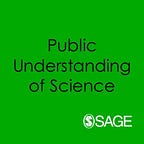Sharing Our Science: How to Write and Speak STEM
Review by Anna Maria Fleetwood
Brown highlights the power of language — how it can be used to build walls between people, and between different groups — but the book also demonstrates how to use language to overcome gaps and to be more inclusive.
This book is aimed specifically at scientists and students working within STEM. Nevertheless, if you are working with science communication, that is, supporting scientists in the field, you can find some eye-openers as well. Particularly interesting are the examples that illustrate how language can be used to build bridges between scientists in different sectors or between scientists and the general public. One of these is a striking metaphor from Nobel laureate Elizabeth Blackburn (now on display at the Nobel Prize Museum in Stockholm), who likened telomeres that protect the ends of chromosomes to caps on the ends of shoelaces, ensuring that all the important DNA instructions get copied.
There is an increasing need and demand for communicating STEM in a more conveying and inclusive way. The author draws on his own experience as a communicator to various audiences and in various media. The book evolved from a need he felt for guiding principles aimed at researchers in engineering and technology. It is eminently suited to be a handbook for STEM practitioners looking to communicate their technical work. It also highlights the necessity for scientists to reflect on their role and to be honest with themselves about their prevalent biases.
Brown highlights the power of language — how it can be used to build walls between people, and between different groups — but the book also demonstrates how to use language to overcome gaps and to be more inclusive. It is full of examples of how researchers can spice up their writing, for example, by using active verbs, to attract a wider range of readers.
The author is a professor of physics and writer of Planck: Driven by Vision, Broken by War. He has also written for popular-scientific outlets and served as a writing coach. In 13 chapters, he covers a broad spectrum of principles that impact on different scientific communication tasks from white papers, grant proposal, lab reports, slide decks, and presentations to Zoom meetings to writing daily emails. Brown demonstrates that the keys to success are clear thinking, knowing what you want to say, and understanding your audience. He urges scientists to get rid of jargon and to use everyday language to get their main points across.
The book presents three main levels of writing — first, fundamental guidelines, such as structuring, getting to know the audience, and making them interested in everything from big questions and broad context to more detailed information; second, focusing on unique scientific work, such as conveying numbers in an impactful fashion; third, using metaphors or comparisons in a fruitful way, and avoid pitfalls such as metaphors with social baggage. Brown also deals with social interaction outside academia, such as public speaking and writing for a broader audience, and he touches on dealing with communicating calamities.
The book’s title, Sharing Our Science, already states the book’s overall aim to illustrate the importance of understanding and including the reader. Brown emphasises the need for every scientist to step out of his/her comfort zone. He puts the spotlight on science and scientists in a social context. He talks about how he has learned from his dialogues and networking with colleagues from different fields within STEM, but also from interaction with the broader public outside academia. Every chapter ends with a summary and I found these summaries very helpful; they could easily stand by themselves.
The book does not fully develop the connection between what is commonly defined as scholarly communication, that is, within academia and between researchers, and science communication that concerns communication about research with those outside the scientific community. It would have been valuable for Brown to have included and referred to more research in science communication and scientific journals from the field. He does, however, refer to studies in other areas, e.g. linguistics and social psychology, which has an impact on the book.
This book is a practical and entertaining guide to communicating science. It sets out a rationale for communicating in STEM. It outlines the personal benefits to researchers of improving their writing — not only that readers will get a better grasp of their work, but that it also will open more doors in their working life. I found one piece of advice particularly useful, easy and unpretentious: “Read your sentences aloud. Awkward and convoluted phrasing will draw your editing attention.”
Anna Maria Fleetwood holds a senior advisory role with the Swedish Research Council that includes working with stakeholders across the EU and globally, enhancing evidence bases to inform decision-makers and society at large. Anna Maria lectures on science communication. She is a trained art historian and has a background as an arts critic.
